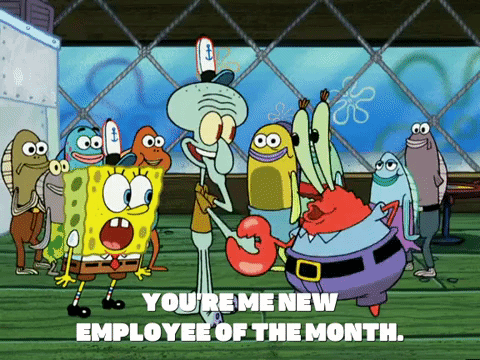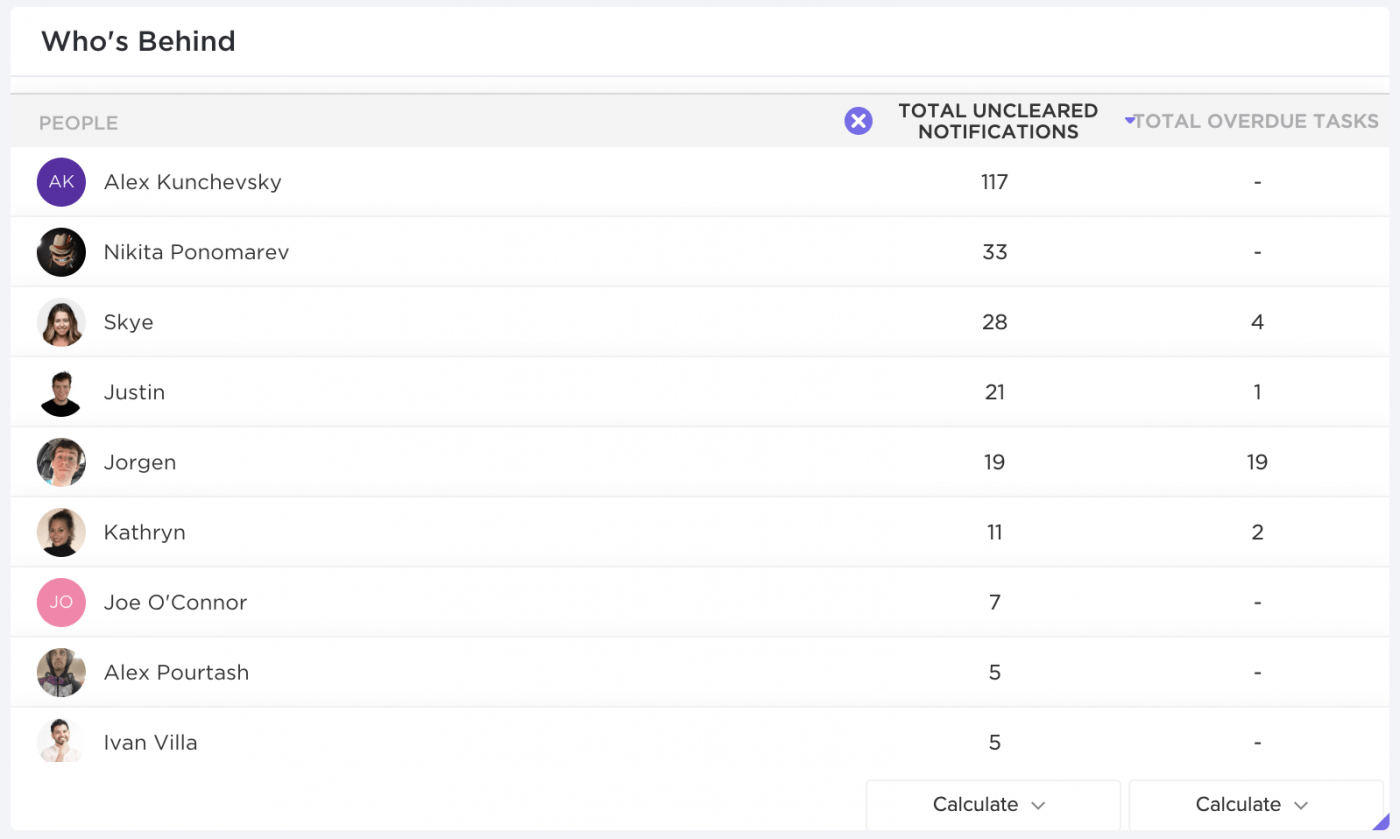إن اختيار مؤشرات الأداء الرئيسية المناسبة للموارد البشرية يشبه تعيين أفضل متخصصي الموارد البشرية.
_ ماذا نعني؟
أثناء عملية التوظيف، تريد اختيار الأشخاص الذين سيقودون شركتك إلى النجاح، أليس كذلك؟
وبالمثل، أنت بحاجة إلى اختيار مؤشرات الأداء الرئيسية للموارد البشرية المناسبة التي ستحقق النتائج لشركتك.
_ولكن مع وجود الكثير من مؤشرات الأداء الرئيسية الرائعة للموارد البشرية، كيف يمكنك معرفة أي منها يجب عليك تتبعها؟
_لا تقلق!
في هذه المقالة، سنستعرض كل ما تحتاج إلى معرفته حول مؤشرات الأداء الرئيسية للموارد البشرية ونلقي نظرة على مؤشرات الأداء الرئيسية العشرة أفضل مؤشرات الأداء الرئيسية والمقاييس التي تحتاج إلى تتبعها اليوم. سنغطي أيضًا أسهل لتتبع مؤشرات الأداء الرئيسية للموارد البشرية.
لنبدأ العمل
ما هي مؤشرات الأداء الرئيسية للموارد البشرية؟
أولاً، دعنا نوضح ما تعنيه مؤشرات الأداء الرئيسية:
يرمز KPI إلى Key P أداء I مؤشر .
مؤشرات الأداء الرئيسية هي مقاييس قابلة للقياس تُظهر للمؤسسة ما إذا كانت تحقق أهداف العمل الأساسية. ولهذا السبب يجب استخدام مؤشرات الأداء الرئيسية للموارد البشرية لتتبع أداء أنشطة الموارد البشرية لديك.
إن قسم الموارد البشرية لديك مسؤول عن توظيف أفضل المواهب و الاحتفاظ بها ، وبدون لوحة مؤشرات الأداء الرئيسية للموارد البشرية لإرشادهم حول مدى جودة أدائهم، قد يشعر الموظفون (وحتى المديرون) بالارتباك.
10 مؤشرات أداء ومقاييس رئيسية للموارد البشرية
لتسهيل مهمتك، وضعنا لك قائمة مختصرة بعشرة مقاييس ومؤشرات أداء رئيسية لأداء الموارد البشرية.
ولجعلها أكثر شمولاً، قمنا أيضاً بتنظيم مؤشرات الأداء الرئيسية في ثلاث فئات مختلفة:
- التوظيف
- مشاركة الموظفين%ref/
مؤشرات الأداء الرئيسية للتوظيف
يعد التوظيف من أهم وظائف الموارد البشرية، لذلك تحتاج بالطبع إلى بعض مؤشرات الأداء الرئيسية للتوظيف.
التوظيف تحدد مؤشرات الأداء الرئيسية فعالية عملية التوظيف لديك . إنها مقاييس الموارد البشرية التي تساعدك على تقليل تكاليف التوظيف والاحتفاظ بأفضل المواهب.
إليك بعض الأمثلة:
التكلفة لكل موظف
يقيس هذا المقياس متوسط عدد الموارد التي استثمرتها في توظيف موظف واحد.
_انتظر، ما هي الموارد؟
تشمل موارد التوظيف ما يلي التسويق ونفقات الإعلان، وعملية التوظيف، و الإحالات .
قد تعني التكلفة المرتفعة لكل عملية توظيف أنك بحاجة إلى تحسين مجالات محددة في عملية التوظيف لديك. من خلال القيام بذلك، يمكنك تقليل تكلفة التوظيف وتحسين عملية التوظيف لديك كفاءة عملية التوظيف .
إليك كيفية حسابها:
التكلفة لكل تعيين = (إجمالي تكاليف التوظيف الداخلي + تكاليف التوظيف الخارجي + تكاليف التوظيف الخارجي) (إجمالي عدد التعيينات في إطار زمني معين)
معدل الاحتفاظ بالموظفين
يقيس معدل الاحتفاظ بالموظفين مدى قدرة شركتك على الحفاظ على تحفيز أفضل الموظفين لديك وتفاعلهم. ويشمل ذلك الممارسات والاستراتيجيات التي تهدف إلى إبقاء موظفيك سعداء ومدربين ومستعدين بحيث يتفوقون في عملهم.
على سبيل المثال، تحفيزهم من خلال التقدير والجوائز. 🏆

يساعد مقياس الموارد البشرية هذا الشركات في الحصول على نظرة ثاقبة حول سبب اختيار أصحاب الأداء الأفضل للبقاء في شركتهم. وبهذه الطريقة، يمكن لمؤسستك أن تظل قادرة على المنافسة في الرواتب و المزايا عند تعيين موظفين جدد.
إليك كيفية حسابها:
معدل الاحتفاظ بأفضل المواهب = إجمالي عدد الموظفين - إجمالي عدد الموظفين المستقيلين إجمالي عدد الموظفين
معدل دوران الموظفين في السنة الأولى معدل دوران الموظفين يقيس عدد الموظفين الذين تفقدهم خلال فترة من الزمن.
يحسب معدل دوران الموظفين في السنة الأولى النسبة المئوية للموظفين الذين يستقيلون في أقل من عام واحد من انضمامهم إلى مؤسستك.

يُظهر معدل دوران الموظفين في السنة الأولى إذا كنت بحاجة إلى تحسين التوظيف و عمليات التأهيل نظرًا لأن الاستقالات المبكرة تشير إلى عدم تطابق أساسي بين الموظف الجديد والشركة.
إليك كيفية حساب ذلك:
السنة الأولى معدل الدوران = مجموع عدد الموظفين الذين يغادرون عدد الموظفين الذين استقالوا خلال نفس الفترة
مؤشرات الأداء الرئيسية لمشاركة الموظفين
تساعدك مؤشرات الأداء الرئيسية لمشاركة الموظفين على تحديد ما إذا كانت مؤسستك تضع السياسات الصحيحة للحفاظ على مشاركة موظفيك.
ويشمل ذلك التدريب المناسب، والمزايا، وبيئة العمل الصحية. هذه العناصر تعزز مشاركة الموظفين وتقليل معدلات دوران الموظفين.
دعنا نلقي نظرة على بعض مؤشرات الأداء التي ستساعدك على تحديد مدى تفاعل موظفيك:
مؤشر رضا الموظفين
رضا الموظفين هو مؤشر أداء رئيسي مهم يقيس مدى سعادة موظفيك.
_ لماذا هذا مهم؟
إن إبقاء موظفيك سعداء ومشاركين يقلل من معدلات دوران الموظفين.
_ولكن كيف تعرف ما إذا كان موظفوك يحبون عملهم حقًا أم أنهم يتمسكون بوظائفهم من أجل الراتب فقط؟
يمكنك تحديد مدى رضا الموظفين من خلال الاستبيانات عبر الإنترنت, المقابلات أو محادثات غير رسمية
صافي نقاط المروجين
يمنحك صافي نقاط المروّج الصافي للموظفين فكرة عن عدد الموظفين الذين يوصون بشركتك كمكان للعمل.
هناك طريقة بسيطة للقيام بذلك وهي أن تطلب من الموظفين تصنيف مؤسستك من 0-10:
- 0-6 = غير مروّج ❎
- 7-10 = مروّج ✅
يمكنك استخدام الاستبيانات أو المقابلات لمعرفة سبب شعور المنتقدين بهذه الطريقة تجاه شركتك. من خلال القيام بذلك، يمكن لشركتك تحديد ما قد ينقصها في بيئة العمل الحالية وتقليل معدلات الدوران.
إليك كيفية حساب ذلك:
صافي نقاط المروجين = النسبة المئوية للمروجين - النسبة المئوية للمنتقدين
معدل التغيب عن العمل
يقيس مؤشر الأداء الرئيسي للموارد البشرية هذا مقدار الإنتاجية المفقودة بسبب مرض موظفيك أو تعبهم أو أي سبب آخر للغياب. يمكن تطبيق معدل الغياب على الفرد أو الفريق أو الشركة ككل.
على الرغم من أن مستوى معين من الغياب أمر طبيعي، إلا أن الموظفين الذين يتصلون باستمرار "بالمرض" يعتبرون علامة حمراء. 🚩

قد يعني ذلك أن موظفيك يفتقرون إلى الدافع، أو أنهم محترقون ، أو بيئة العمل غير سارة.
إليك كيفية حساب ذلك:
معدل التغيب عن العمل = مجموع عدد أيام العمل الضائعة بسبب الغياب عدد أيام العمل المتاحة في المنظمة
النسبة المئوية لأيام الإجازات المستخدمة
يتمحور مؤشر الأداء الرئيسي للموظفين هذا حول الحياة العملية التوازن
يجب على شركتك أن تمنح موظفيك عددًا جيدًا من الأيام للذهاب في عطلة، والاسترخاء، والاسترخاء. #SunsOutBunsOut. ⛱

يجب عليك أيضًا تشجيع الموظفين على استخدام أيام إجازاتهم لأن أخذ استراحة من العمل يمكن أن يعزز إنتاجية الموظف.
إليك كيفية حساب ذلك:
النسبة المئوية لأيام الإجازة المستخدمة = عدد أيام الإجازة المستخدمة عدد أيام الإجازة غير المستخدمة x100
مؤشرات الأداء الرئيسية للتعويضات والمزايا
تقيس مؤشرات الأداء هذه مقدار الأموال والموارد الأخرى التي تستثمرها شركتك في موظفيك. ويشمل ذلك الرواتب والتدريب والحوافز وأي شيء آخر تدلل به موظفيك. 💁
يمكن أن تساعد هذه العناصر في تقليل معدل دوران الموظفين.
دعنا نلقي نظرة على بعض هذه العناصر:
نسبة تنافسية الراتب
_هل تعرف كيف تتنافس الشركات على جذب العملاء؟
وبالمثل، يتنافس قسم الموارد البشرية لديك مع الشركات الأخرى لجذب أفضل المواهب.
وبالطبع، فإن تقديم حزمة رواتب لافتة للنظر هي إحدى الطرق للقيام بذلك!
إن نسبة تنافسية الرواتب هي مقياس لمدى تنافسية رواتب شركتك مقارنةً بالشركات الأخرى التي تقدم نفس الأدوار الوظيفية.
إن ارتفاع نسبة تنافسية الرواتب يمنح شركتك ميزة تنافسية على منافسيك.
_أنت تعرف ماذا يقولون: المال يتحدث. 🤑 🤑
إليك كيفية حساب ذلك:
نسبة تنافسية الراتب = الراتب الذي تقدمه شركتك الراتب الذي يقدمه منافسك
النسبة المئوية لتكلفة القوى العاملة
يجب أن تشمل النسبة المئوية لتكلفة القوى العاملة الأموال المنفقة على الرواتب, التدريب وتكاليف التوظيف والمزايا والمكافآت.
يجب عليك أيضًا تضمين أي تكاليف أخرى مثل الضرائب والتأمين ودفع الإجازات وأجر العمل الإضافي.
تذكر، من الناحية المثالية، كلما استثمرت أكثر في رأس المال البشري ، كلما زادت إنتاجية موظفيك
مؤشر الأداء الرئيسي أعلاه ضروري لاتخاذ القرارات المتعلقة بزيادة الرواتب والترقيات والتعيينات الجديدة و برامج التدريب .
_لماذا؟
إلا إذا كنت تريد القيام بذلك

يجب عليك استخدام البيانات المستقاة من هذا المقياس للحصول على نظرة ثاقبة لما يمكنك إنفاقه على موظفيك.
إليك كيفية حساب ذلك:
النسبة المئوية لتكلفة القوى العاملة = تكلفة القوى العاملة في الشهر إجمالي تكاليف تشغيل الشركة x100
مصروفات الرعاية الصحية لكل موظف حالي
يقيس هذا المقياس مقدار ما تنفقه شركتك على خطط الرعاية الصحية لكل موظف.
_في النهاية، الموظفون الأصحاء هم موظفون سعداء، أليس كذلك؟
إن تقديم خطة رعاية صحية جيدة سيساعد شركتك على جذب الموظفين والاحتفاظ بهم. ولكن من الضروري أيضاً التأكد من أن مزود الرعاية الصحية الخاص بك لا يبالغ في فرض رسوم زائدة.
إذا كانت هذه هي الحالة، يمكنك التبديل إلى مزود رعاية صحية بأسعار أقل أو الحصول على خطة رعاية صحية أفضل!
إليك كيفية حساب ذلك:
مصروفات الرعاية الصحية لكل موظف حالي \= السعر الإجمالي لتكاليف الرعاية الصحية إجمالي عدد الموظفين
تعرف على المزيد عن مفيد_*
_/مرجع/ مدونة؟ p=44200_ أدوات الموارد البشرية والنصائح *%/href/_
يمكن أن تساعدك في جعل العملية برمتها أكثر فعالية.
## كيفية تتبع مقاييس مؤشرات الأداء الرئيسية للموارد البشرية
تحدد مؤشرات الأداء الرئيسية للموارد البشرية ما إذا كان قسم الموارد البشرية لديك يحقق أهداف الموارد البشرية الإجمالية للمؤسسة.
_ولكن كيف تعرف ما إذا كان قسم الموارد البشرية لديك يحرز تقدماً؟
دعنا نسألك هذا السؤال:
هل ما زلت تتبع مقاييس الموارد البشرية الخاصة بك باستخدام أوراق إكسل ?_

إذا كنت تفعل ذلك، يرجى التوقف.
تحتاج إلى موارد بشرية قوية أداة مؤشرات الأداء الرئيسية مع الميزات الصحيحة
و أفضل مرشح لهذه الوظيفة هو انقر فوق !
دعنا نلقي نظرة على كيفية مساعدة ClickUp لفريق الموارد البشرية لديك:
1. تحديد أهداف الموارد البشرية
قبل أن تبدأ في تتبع أي شيء، تحتاج إلى تحديد بعض أهداف الموارد البشرية!
الأهداف
هي عبارة عن حاويات عالية المستوى يمكن تقسيمها إلى حاويات أصغر قابلة للقياس
الأهداف.

الأهداف هي الأهداف التي تحتاج إلى تحقيقها للوصول إلى مؤشر الأداء الرئيسي للموارد البشرية.

نظرًا لأن مؤشرات الأداء الرئيسية تتعلق بالأداء، فإن ClickUp يحفزك من خلال إظهار تقدمك في مؤشرات الأداء الرئيسية في كل خطوة على الطريق. 👣
في كل مرة تكمل فيها هدفًا، سترى مدى قربك من الوصول إلى مؤشر الأداء الرئيسي الخاص بك.

يمكنك أيضًا تخصيص المقاييس التي تختارها لتتبع مؤشرات الأداء الرئيسية الخاصة بك، مثل:
- الأرقام: أرقام رقمية مثل التكلفة لكل موظف أو تكاليف التدريب
- العملات: تتبع أموالك
- المهام: تحقق مما إذا كان فريق الموارد البشرية لديك ينجز مهام الموارد البشرية الخاصة به

هل أنت مرتبك حول كيفية اختلاف مؤشرات الأداء الرئيسية عن المقاييس؟ إليك منشور على الـ الاختلافات بين مؤشرات الأداء الرئيسية والمقاييس .
2. إدارة مؤشرات الأداء الرئيسية للموارد البشرية لوحات معلومات ClickUp توفر لك جميع تحليلات الموارد البشرية التي تحتاجها لإدارة مؤشرات الأداء الرئيسية الخاصة بك.

لوحة معلومات الموارد البشرية هي مركز التحكم في مهامك حيث يمكن لمديري الموارد البشرية الحصول على نظرة عامة عالية المستوى عن أداء فريق الموارد البشرية لديك. 🚀
علاوة على ذلك، يمكنك اختيار الطريقة التي تريد عرض البيانات بها.
إليك قائمة ببعض من أدوات مخصصة يمكنك إضافتها إلى لوحة معلومات مؤشرات الأداء الرئيسية الخاصة بك:
- مخطط خطي: إنشاء مخطط خطي بالبيانات التي تختارها 📈
- مخطط شريطي: إنشاء مخطط شريطي مخصص مع أي بيانات 📊
- محفظة : تصنيف وتتبع التقدم المحرز في عمليات الموارد البشرية الخاصة بك
- الحساب : حساب المجاميع والمتوسطات والبيانات الرقمية الأخرى
- الدردشة : قم بإجراء محادثات مع فريقك داخل لوحة معلومات الموارد البشرية الخاصة بك

3. تتبع أداء فريق الموارد البشرية لديك
عندما تقوم بتعيين موظف، _لا تزال بحاجة إلى تتبع أدائه للتأكد من أنه يقوم بعمله بالفعل، أليس كذلك؟
وبالمثل، تحتاج إلى تتبع أداء فريق الموارد البشرية لديك بانتظام.
_ولكن كيف تفعل ذلك؟
ببساطة قم بإضافة أدوات الجدول إلى لوحة معلومات مؤشرات الأداء الرئيسية للموارد البشرية.
باستخدام هذه الأدوات، سيكون لديك كل ما تحتاجه لتصور أداء الموظفين.
إليك بعض الأدوات التي ستحصل عليها:
- تقرير المنجز: معرفة عدد المهام التي أنجزها كل عضو في الفريق
- المهام التي تم العمل عليها: معرفة عدد المهام التي عمل عليها كل عضو في يوم أو أسبوع أو شهر معين
- نقاط مساحة العمل: قم بتلعيب أنشطة الموارد البشرية لديك حتى تتمكن من تحديد أصحاب الأداء الأفضل 🎮
- من المتخلف عن العمل: تحديد أعضاء الفريق الذين يحتاجون إلى بذل المزيد من الجهد من خلال معرفة عدد الإشعارات غير المنجزة والمهام المتأخرة

الوصول إلى هذه تقارير مؤشرات الأداء الرئيسية مفيد بشكل خاص لما يلي الفرق البعيدة .
_لماذا؟
يمكنك التعرف بسرعة على أعضاء الفريق الذين لا يعملون من المنزل.

هل تريد المزيد من أمثلة مؤشرات الأداء الرئيسية؟ إليك أكثر من 50 مثالاً على مؤشرات الأداء الرئيسية وقوالب .
الأسئلة الشائعة حول مؤشرات الأداء الرئيسية
فيما يلي إجابات لبعض الأسئلة الشائعة حول مؤشرات الأداء الرئيسية للموارد البشرية:
ما هي بطاقة الأداء المتوازن للموارد البشرية؟
A بطاقة الأداء المتوازن (BSC) هي استراتيجية أداة تخطيط التي تساعد الفرق في الحصول على تصور "متوازن" لأدائها.
تسرد BSC الأهداف لأربعة مجالات محددة:
الأهداف المالية
ويشمل ذلك خفض أو إدارة تكاليف الموارد البشرية، وتقليل الوقت الضائع بسبب شواغر الموظفين، وتحسين تدريب الموظفين.
أهداف العملاء
لدى أقسام الموارد البشرية عميلان: الموظفون وقادة الأقسام.
تركز أهداف العملاء على ما تتوقعه هاتان المجموعتان من قسم الموارد البشرية.
على سبيل المثال، يتوقع الموظفون أن يقوم فريق الموارد البشرية بتعزيز ثقافة الشركة، ويتوقع قادة الأقسام أن يقوم قسم الموارد البشرية بتوظيف أفضل المواهب.
المكافأة:_
_/href/ مدونة؟ ص=67981 برنامج إدارة المواهب *%/href/_
!
أهداف العملية الداخلية
وتشمل الأهداف المتعلقة بالتوظيف، والتدريب، وتشكيل ثقافة الشركة، وتحسين التواصل .
على سبيل المثال، يمكنك إعداد مدونة داخلية للشركة لتوصيل رؤية شركتك ومشاركة المعلومات بين الفرق المنفصلة.
التعلم وأهداف النمو
تتمحور هذه الأهداف حول كيفية تخطيط قسم الموارد البشرية لديك لتطوير فريق عمل عالي التدريب.
يجب أن يتعلم قسم الموارد البشرية لديك وينمو إلى الحد الذي لا يحتاج فيه إلى أي تدريب بعد الآن!
أو على حد تعبير يودا

بشكل أساسي، تشجع اتفاقية الدعم الوظيفي الأساسي فريق الموارد البشرية لديك على التركيز على الأنشطة التي تدعم الأهداف العامة للشركة. ومن خلال القيام بذلك، فإنه يعرض قيمة قسم الموارد البشرية لديك.
خصائص مؤشرات الأداء الرئيسية الجيدة للموارد البشرية
تتسم مؤشرات الأداء الرئيسية المفيدة للموارد البشرية بخمس سمات:
بسيطة
يجب أن تؤدي مؤشرات الأداء الرئيسية التي تضعها إلى إجراءات، وليس المزيد من الأسئلة.
قد تؤدي الأهداف المعقدة إلى إرباك فريق الموارد البشرية لديك وتتسبب في تأخير تحقيق تلك الأهداف!
يضمن وضع مؤشرات أداء رئيسية واضحة ومباشرة أن يعرف فريق الموارد البشرية لديك ما هو المتوقع منهم بالضبط.
قابلة للتنفيذ
يجب أن تكون مؤشرات الأداء الرئيسية الخاصة بك واقعية أيضاً.
_لماذا؟
_إن وضع أهداف غير قابلة للتحقيق هو أمر محبط للغاية لأي فريق!
ذات صلة
يجب أن تكون مؤشرات الأداء الرئيسية للموارد البشرية ذات صلة باستراتيجية الموارد البشرية الخاصة بك.
على سبيل المثال، لنفترض أنك مدير موارد بشرية، وهدفك هو زيادة المشاركة على وسائل التواصل الاجتماعي.
هذا ليس مثالياً.
_لماذا؟
لا يساهم الهدف في دورك في المنظمة، كما أنه لا يساهم في تعزيز مسيرتك المهنية .
قابل للقياس أهداف قابلة للقياس لها مبالغ وبيانات وأطر زمنية محددة.
على سبيل المثال:
خفض معدل دوران الموظفين لدينا بنسبة 20% بحلول الربع الثاني من العام
محاذاة
يجب أن تتماشى مؤشرات الأداء الرئيسية للموارد البشرية لديك مع هدف العمل الشامل.
على سبيل المثال، فإن المؤسسة التي تركز فقط على خدمة العملاء ستعطي الأولوية لأهداف الاحتفاظ بالعملاء على أهداف اكتساب العملاء.
بالإضافة إلى هذه السمات، نوصي أيضًا بما يلي باستخدام أهداف SMART ! الأهداف الذكية هي:
- محددة
- قابلة للقياس
- قابلة للتحقيق
- ذات صلة بالموضوع
- محددة زمنيًا
ضع هذه الأمور في اعتبارك عند إنشاء مؤشرات الأداء الرئيسية للموارد البشرية!
حان الوقت لوضع بعض مؤشرات الأداء الرئيسية للموارد البشرية 🛥
توضح لك مقاييس الموارد البشرية ما إذا كنت تحقق جميع أهداف الموارد البشرية الخاصة بك.
إنها مؤشرات الأداء الأساسية التي تحتاجها كل مؤسسة لتتبع أداء قسم الموارد البشرية لديها.
لكن مجرد اختيار مؤشر أداء رئيسي لا يكفي.
فأنت بحاجة إلى تتبعها أيضاً!
وللقيام بذلك، تحتاج إلى أداة مثل ClickUp.
من السماح لك بإنشاء قوالب تأهيل الموظفين , قوالب الموارد البشرية أو تطبيق النشر النماذج ، يحتوي ClickUp على كل ما تحتاجه لإدارة كل من مؤشرات الأداء الرئيسية الخاصة بك و التوظيف العملية. احصل على ClickUp مجاناً اليوم ، حتى يعرف قسم الموارد البشرية بأكمله ما يجب القيام به بالضبط ومتى يجب القيام به!


